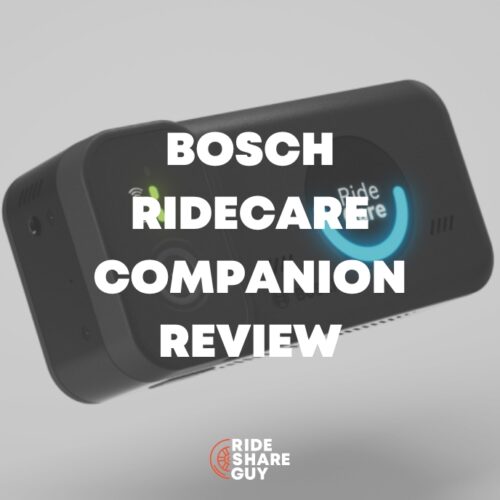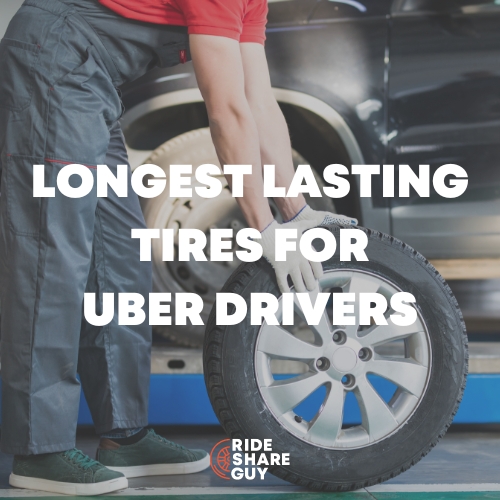RSG’s goal is to help break down rideshare driving for you – and that includes what happens when you get deactivated or threatened with deactivation. We’ve created a guide on how you can avoid deactivation here, and how to handle getting reactivated if you have been deactivated.
In order to remain an active rideshare driver, you need to adhere to Uber and Lyft’s deactivation policy guidelines. However, it’s more than simply following their stated guidelines that will help you stay active on their platforms.
Here are some tips on what to do and not do to remain an Uber and Lyft driver in good standing. Keep in mind, these are not guaranteed but more of guidelines you should be following.

Things You Definitely Should Be Doing to Avoid Deactivation
Treat Your Passengers With Respect
Give a friendly greeting. Gauge your passengers. Some want to talk. Others want to be left alone. Treat them as you would want to be treated, with compassion, respect and understanding.
Give Your Passenger Personal Space
Most passengers will sit in the back seat. Some will sit in the front. Be cognizant of your spatial distance to your passengers. Allow them to feel comfortable and safe in your car. Never touch your passengers.
Keep Your Rating Above a 4.6
I looked on the Internet for any specific guidelines regarding unacceptable ratings. A rating of 4.6 seems to be the lowest you can go before you get a warning or deactivation.
If you are getting close to a 4.6, you need to ask yourself why your rating is so low. Most passengers give a 5 unless you do something upsetting. Don’t be rude or obnoxious. Pick up and drop off your passengers on time and at the correct location. The number one complaint from passengers is a bad route and lack of city knowledge. All of this can be remedied by becoming proficient at using Waze or your GPS of choice for navigation.
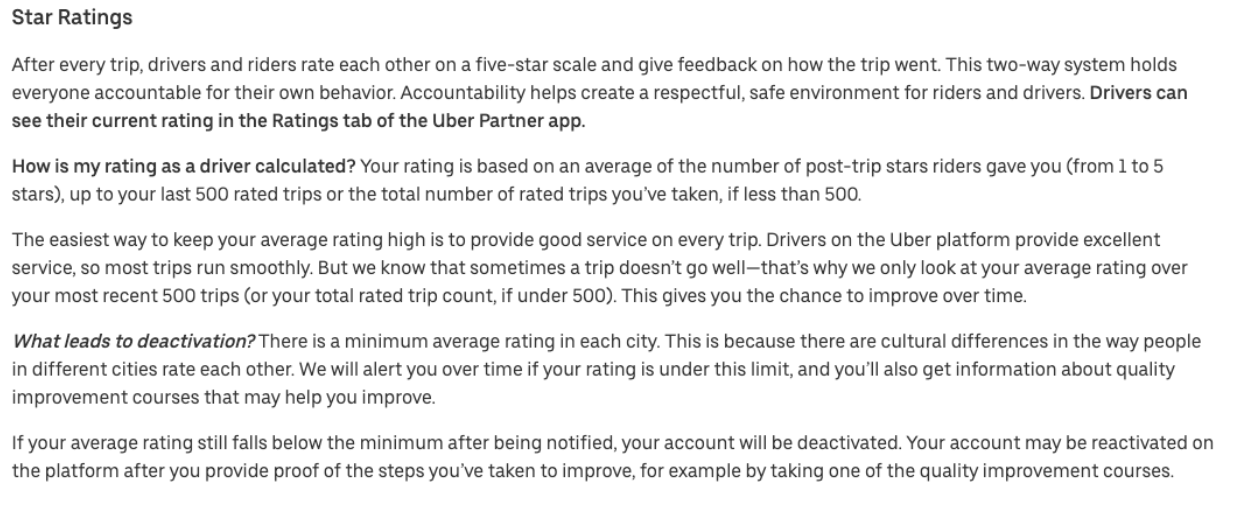
Keep Your Cancellation Rate Below 10%
If you accept a ride, take the ride. Both companies monitor your cancellation rate. They don’t want passengers expecting a pick up and then the driver does not show up. 1 out of 10 is acceptable. Below that, and you may get a warning and possible deactivation.
Editor’s Note: As of Feb. 6, 2018, Uber no longer deactivates for a low acceptance rate, but cancellation rate is still a concern.
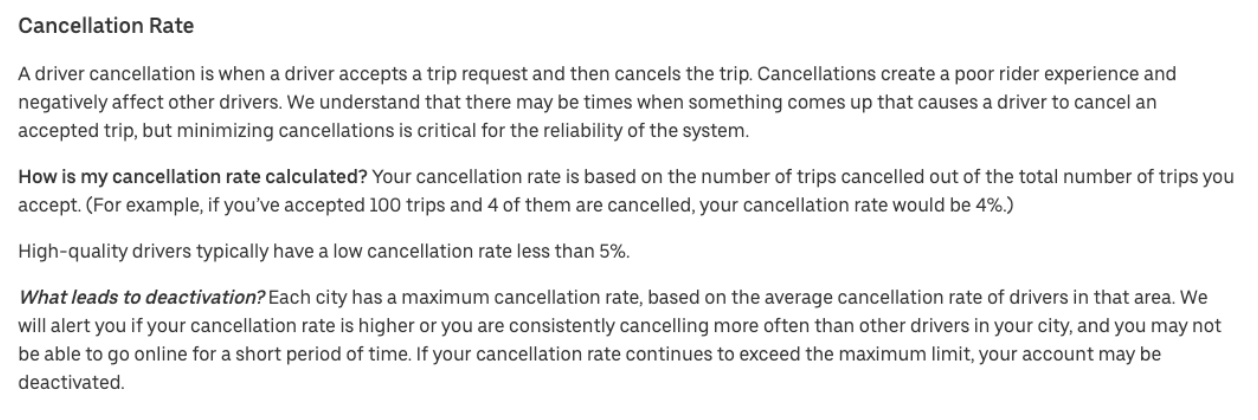
Drive Safely and Follow All Traffic Laws
Slow and easy. No rush. Give your passengers a pleasant drive. Even if your passenger says they are in a hurry, you need to follow the speed limit and all laws of the road. I’ve had passengers tell me they are in a hurry and my response is usually, “I’ll get you there as fast as I legally can.” They get a little laugh out of it while also realizing there’s only so much I can do to get them there “quickly.”
One reason you could get deactivated is if your car doesn’t qualify to drive for rideshare anymore. If you still want to drive rideshare but your car no longer qualifies, consider using a service such as HyreCar to rent a vehicle for rideshare driving on a daily, weekly or monthly basis.
Maintain All Your Paperwork
If you forget to update your vehicle inspection documents, on the date they are set to expire, you will be immediately, though temporarily, deactivated. Keep your documents up to date. If you do forget, upload them as soon as possible. Once you do and your paperwork is approved, you should be road-ready once more.
To make this process go a little faster, it helps to go into your Greenlight Hub and have them upload the documents. They are usually approved immediately and you can get on the road faster. Otherwise, if you upload them from home, you might have to wait a few hours to a day or two before you can get on the road again.
Provide Accurate Personal Information
Don’t falsify any documents. If you do and you are caught, you will be deactivated. Along with that, don’t let anyone else use your driver account (see more about this in the “Fraud” part of this article).
Pick Up Passengers with Service Animals
I love to get a passenger with a dog. Dogs are great. It is illegal to refuse a passenger who has a service dog. Service animals are not only seeing eye dogs for the blind. Many people keep a small dog with them for emotional support. You must accept these passengers and their furry friends.
Editor’s Note: Drivers do not have to transport emotional support animals per Uber and Lyft’s policies. However, we have heard from many drivers who have been deactivated by Uber and Lyft for refusing emotional support animals because the passengers complained.
If you refuse an emotional support animal, we highly recommend you purchase a dash cam in case a rider complains that you wouldn’t take their “service animal.”
Doing These Things Can/Will Get You Deactivated
Driving a Child Who is Unaccompanied by an Adult
In Lyft’s Terms of Service, you cannot give a ride to a child who is 17 years old or younger unless they are accompanied by an adult. You can click here to read their policy.
With Uber, it can be a little tricky. Uber states,
“In most cities, a rider must be at least 18 years of age to have an Uber account and request rides. Anyone under 18 must be accompanied by someone 18 years of age or older on any ride.
As a driver-partner in a city that doesn’t allow minors to ride, you should decline the ride request if you believe the person requesting the ride is under 18.”
You can read more on Uber’s statement here.
This is all pretty interesting, because for a while Uber did have the Uber Teen program in a few cities. That seems to have gone away for now. Uber now has Uber Family, but according to Uber’s policy, family account holders also have to be age 18 to request a ride.
All of this to say: you can and should decline a ride, according to Uber and Lyft’s policies, for a minor…but you can also probably/possibly expect someone to complain about you for doing so. On the other hand, if you do accept the ride, you could be deactivated or if you are pulled over, you could be looking at worse.
Engaging In Sexual Talk or Sexual Activity With a Passenger
You should have a firm “no sex with passengers” rule. While not spelled out by Uber or Lyft, it’s advisable to avoid this kind of situation. Do not have sex with a passenger. Do not come on to a passenger. Do not flirt. If they are flirting with you, politely decline the advances.
A rideshare contributor received a warning because one passenger (UberPOOL ride) insisted on talking about his sexual conquest the night before and a female passenger felt uncomfortable. Avoid and defuse any and all conversations about sex. While it is not policy, I also recommend avoiding any talk about politics and religion.
Attempting to Contact Any Passengers After the Ride Is Over
While you might feel like you’ve made a meaningful connection during a ride, especially if you drive at night, leave it there. Pursuing a passenger for any type of a relationship after the ride is over will get you deactivated.
Texting While Driving
In most states, texting while driving is illegal and can earn you an expensive citation. Only use your phone to manage your rides. Stay off of all social media, email and texting apps. Another thing to keep in mind is answering personal phone calls while driving. It might not get you deactivated, but could lead to a low rating from that passenger.
Drinking and/or Doing Drugs While Driving
I have had many passengers tell me they have been in the car of drivers who smelled like marijuana. Save it for after your shift, and don’t do it in the car you drive for Uber or Lyft. That smell lingers and your passengers will notice it.
If you get any passengers who reek of marijuana or alcohol, make sure to drive around with your windows down to air out the car after they’re gone. Do this for at least 5-10 minutes before picking up your next passenger.
Driving When Drowsy or Tired
As drivers, we must be responsible for our attentiveness while on the road. If you are tired, stop your shift and take a nap or end it and go home for the day. You’re dangerous to yourself and others if you’re driving around tired, and passengers will likely report you to Uber or Lyft if you seem to be too sleepy to be driving.
Using Inappropriate and Abusive Language Or Gestures
I had one passenger swear at me. If this happens to you, do not swear back. Control your emotions and wish them a good day. Also, control your road rage. I’ve had passengers swear at other drivers on the road. I kept my mouth shut and just kept on driving. It would reflect poorly on me if I swore out the other drivers and might make a passenger feel uncomfortable.
Breaking the Law While Driving
Don’t rob a bank (or be an accomplice to robbing a bank). Don’t blow through red lights. Don’t transport drugs. Don’t do anything that is illegal.
Allowing the Law to Be Broken by Passengers During a Ride
If the passenger asks you if he or she can fire up a joint, the answer must be “No.” No drugs in the car. Also, no open alcohol containers in the car. This can land you in a lot of trouble and is illegal.
Safety Issues
Any time you put a passenger’s safety, or even your own safety at risk, you will be deactivated. So, if you’re out driving passengers around drunk, molesting/harassing passengers or just a maniac on the road, you’re going to get deactivated.
Passengers won’t always leave comments for their drivers after the ride is over, but you bet if you put the passenger’s life at risk, they are going to let Uber or Lyft know about it. Additionally, any type of comments related to safety will get flagged/reviewed by Uber staff so expect a swift and quick deactivation if you do anything dumb like drive while under the influence of drugs or alcohol.
Carrying Firearms
Keep the handgun at home. Yes, Uber prohibits firearms in your vehicle and so does Lyft. Yes, I know some states allow concealed carry. It’s still against Uber’s and Lyft’s rules, though, so you’ll have to decide if you want to get deactivated from carrying or if you’d be better off leaving it at home and following the rules you’ve agreed to follow.
Accepting Illegal Street Hails
We are not a taxi service. Only accept Uber and Lyft rides using the app and verify you’re picking up the correct person. This is especially important if picking people up at a busy event. The passengers cannot be trusted to find the right vehicle. You need to be diligent about who you are letting in your vehicle.
Soliciting Cash Payments for Rides
Once a passenger accidentally canceled the ride when he got in the car. I then got another ping within seconds from another passenger. The passenger offered to pay me cash to drive him to his destination. We cannot do this. The passenger had to get out of the car and request a new ride from a different driver, or I would have had to cancel the request I’d gotten and keep my fingers crossed that my next request would be from the person who got in my vehicle, which is a long-shot.
It might seem great, but keep in mind that you’d be putting yourself at risk. If you get into a car accident while giving a cash ride, your car insurance (and Uber or Lyft’s insurance) will not cover you if they find out. It’s just not worth it for a couple of bucks cash.
Committing Fraud
Do not try to game the system. Do not try to steal from other drivers. There was a scam going around a while back in which drivers were called in an effort to gain access to their bank account information. I almost fell for it. Don’t be a thief or a fraud. If/when you get caught, you will be deactivated.

Promoting Competitor’s Services (Including Your Own)
Back in the day, drivers were getting deactivated (or at least threatened with deactivation) for this. The most common thing that I saw drivers getting deactivated for was passing out Lyft referral cards to Uber passengers. I don’t think Uber has a problem with you promoting other services like Doordash or Airbnb, but Lyft is obviously a direct competitor so they don’t like that. It’s not a guaranteed deactivation, but is it worth the risk?
Giving Too Many Rides To Friends, Family or Yourself
On the surface, this may seem innocent enough but behind the scenes, Uber is fighting a constant battle against fraud. They even have a team at HQ that looks for and deactivates drivers and passengers who are caught taking advantage of the system.
Some drivers use friends, family and even their own passenger account to meet ride minimums during guarantee hours or even just to stay active on the platform. It depends on the severity of the infraction but Uber could deactivate you for doing something like this.
A one-off ride to your friend or family member probably won’t be a problem, but a pattern or system of rides is how you’ll get caught since Uber uses algorithms to check for fraud, and then a human reviews each case.
Speaking Out Against Uber
To be fair, we’ve only heard of one instance of this happening (and the driver was reinstated eventually) but in today’s day and age of social media, you always have to be careful with what you say.
Even if you’re posting in a private Facebook group, just assume that anyone could read what you write. Now, that doesn’t mean you should censor what you say, but just understand that businesses don’t like having negative things said about them.
Obviously it’s ridiculous for a driver to be deactivated over a tweet and I doubt Uber would ever do this again, but if you really are causing a lot of trouble for a company on social media, that could affect their image and, in turn, your status with the company.
Having Someone Else In Your Car
There is literally not a single situation in which you can ever have another person (other than your passenger) in your car while driving. I totally understand why some drivers would feel more comfortable or safer with a second person in the car but from a rider’s point of view, this is not acceptable.
There are no exceptions to this rule and if a passenger leaves feedback or an Uber employee happens to take a ride in your car, you will be deactivated immediately. If you don’t feel comfortable driving by yourself, Harry has some tips for you in this video.
Switching Vehicles
This seems pretty obvious to me but several drivers have been deactivated for driving different vehicles than what was listed on their account. There are lots of reasons why this may happen but keep in mind that passengers can see which vehicle is supposed to arrive and they’ll obviously be thinking ‘WTF?’ if you pick them up in a different car.
If you have multiple vehicles that you’d like to use, then a simple solution is to just get them added onto your account and remember to choose the correct one before you start driving for the day.
Discriminating
Do not avoid any neighborhoods based on racial or socio economic profile. Do not avoid picking up anyone based on a person’s race, color, religion, national origin, disability, sexual orientation, sex, marital status, gender identity or age.
Not Giving At Least One Ride Every Few Months
This is more of just a heads up to do your best to stay active on the platform. It’s not a guaranteed deactivation.
In my personal experience, I have not given any rides in the past several months and I have not been deactivated. You might experience a serious lag in ride requests when you do start driving again, but you might not be deactivated from the platform just for not driving enough. This could depend on the area where you’re driving/driver availability, etc. Keep in mind, you’d have to maintain your documents in order to remain active on the platforms as well. If you let your insurance or inspection lapse, you’ll be off the platform until those are updated.
What Happens After You’re Deactivated by Uber
If you are deactivated from Uber, the first step would be figuring out why. They might be upfront about it or they might make you dig a little deeper to uncover the issue. If it’s something like a problem with your background check, your next step would be contacting the background check company to get a copy of the background check in question to see what might be holding things up.
With both Uber/Lyft and the background check company, you’ll want to be diligent about your communications with them. Chances are you’re going to get the runaround. The best you can do is provide all information available to you to combat the reasoning behind deactivation. If you haven’t heard back when they promise to “contact you as soon as we know something” then be sure to send another message.
We’ve experienced more luck with getting support help at our local Greenlight Hubs versus online support. To find a Greenlight Hub (in-person Uber support), click here.
Lyft is very similar:
- Contact Lyft through their app – you’ll want to reach out first via the app, if possible. Simply click on your picture → Help → Help Center for most inquiries, then scroll down to your concern/question or “Contact Support” to ask a specific question.
- Go in-person: Lyft offers a helpful list of hubs nationwide here.
In addition, we’ve heard from other drivers that social media may help. Lyft and Uber appear fairly responsive on Facebook and Twitter. To contact Uber, tweet at @Uber_support with your question or concern. For Lyft, tweet at @askLyft. Keep it brief (as Twitter requires) and don’t send too many messages for them to follow. Uber or Lyft should get back to you within business hours via a “reply” or a direct message (DM).
Fighting Unfair Deactivation
If you are wrongfully deactivated, you can fight back. One big thing to keep in mind is you should be signed up for more than one service at a time. That way, if you are deactivated from one, you have a backup where you can continue earning money in the meantime.
The first thing you want to do is try to solve it on your own by talking with support. Provide any evidence needed to prove that you are following the rules and should be allowed to drive. If you are getting nowhere with phone or email support, stop into your local Hub and talk to a real live person who may be able to better help you.
Another possibility if support is getting you nowhere is to consider finding legal help to fight the deactivation. This is your livelihood, after all.
One thing you can do to fight back against unfair deactivation is to keep a dashcam in your car. This can provide you with some evidence to combat the deactivation if you feel you made no errors on your part. If you feel you may have a legal case against Uber, your footage can come in handy. Try to keep at least 2-3 days of footage on your dashcam or backed up on your computer at all times since you may get a report of an incident hours or even days later.
Learn more: How to Fight an Unfair Deactivation from Uber or Lyft
How to Opt Out of Uber Arbitration
I reluctantly signed the update in order to keep driving, but as I had done with previous updates, I made sure that I was given the choice to opt out of arbitration without retaliation on Uber’s part. The TOS clearly specifies that you have 30 days from the date you sign the agreement to opt out of mandatory arbitration. If you just sign the updated TOS and don’t opt out within the allotted 30 days from the day you agreed to it, you will be forced to go to mandatory arbitration for future disputes and will lose your right to be a part of a class action lawsuit.
I used the Rideshare Drivers United (RDU) Uber arbitration language to opt out, it is very simple to fill out the preconfigured form and email it to optout@uber.com.
If you decide to opt out using the RDU form, this is what you’ll see:
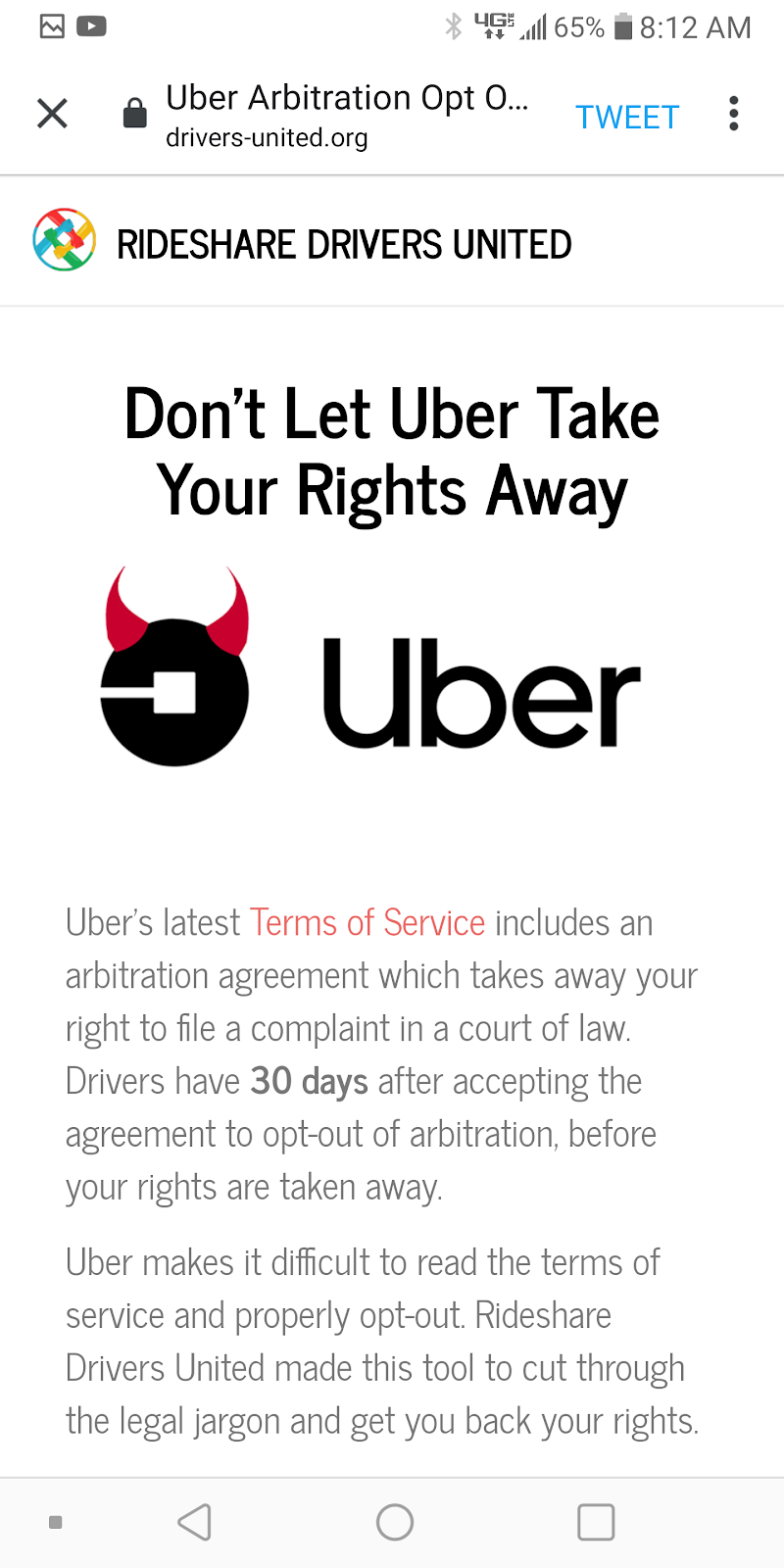
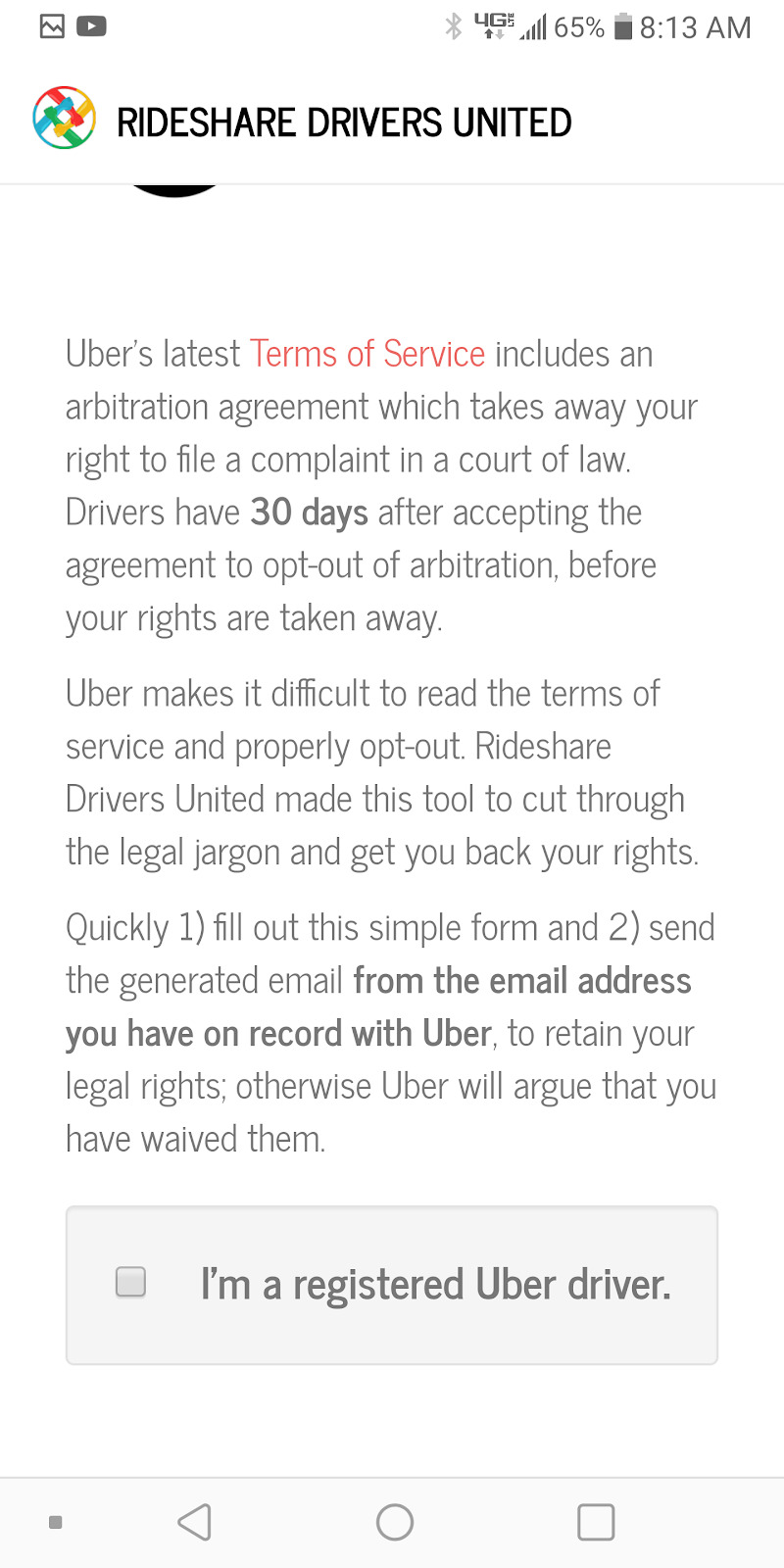
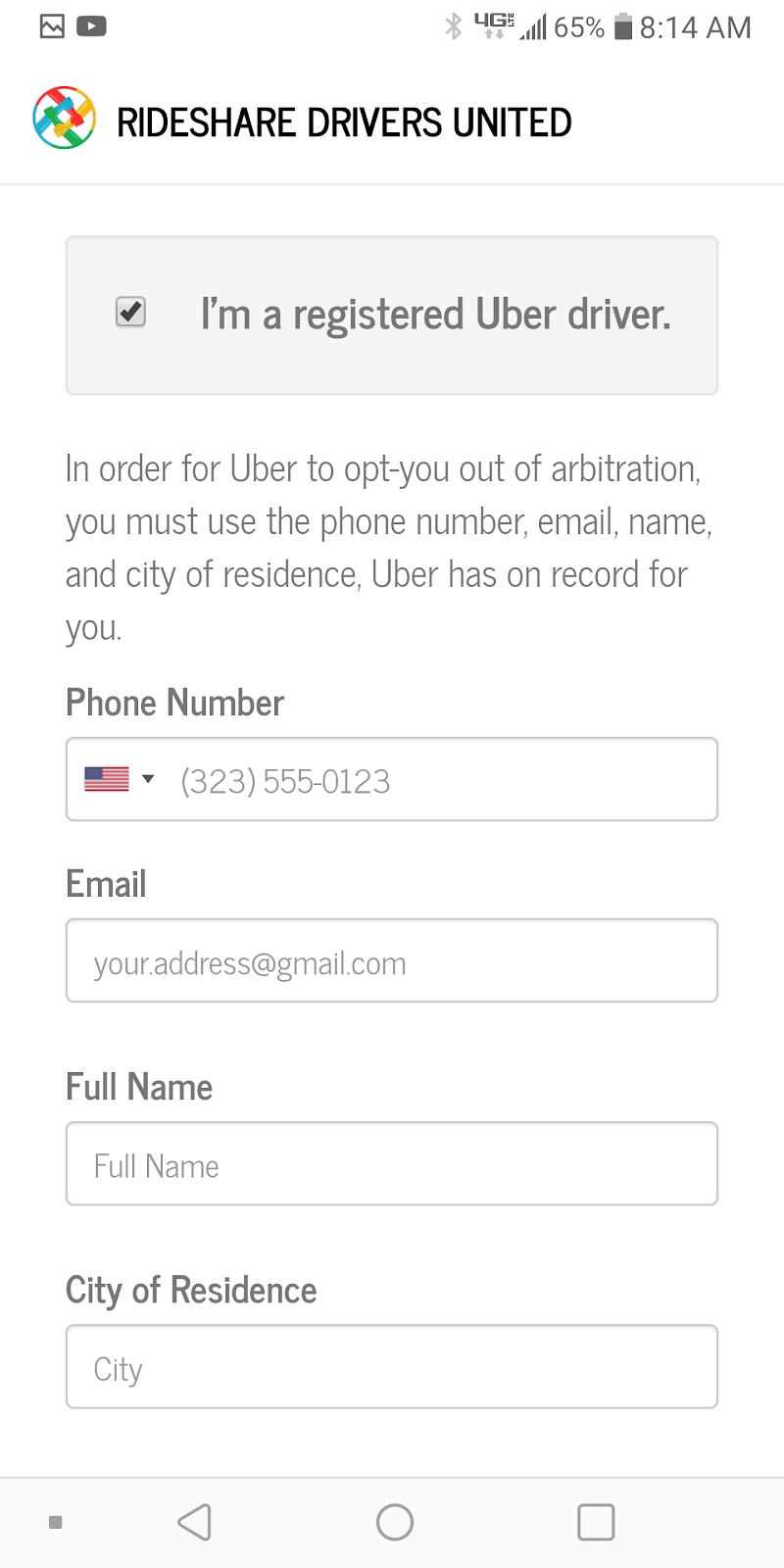
Fill out the necessary boxes with your current information above and you’ll be presented with the following screens.
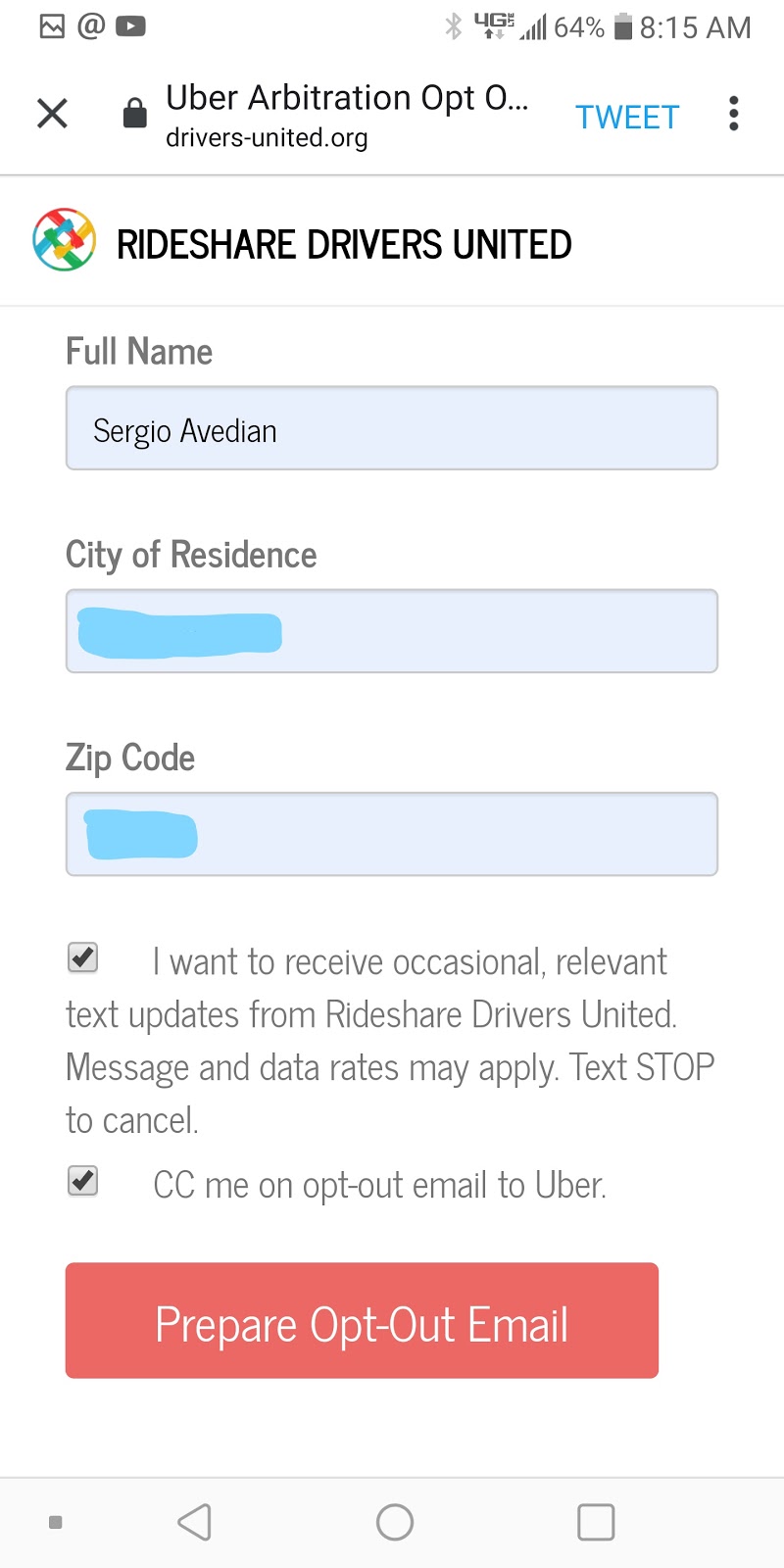
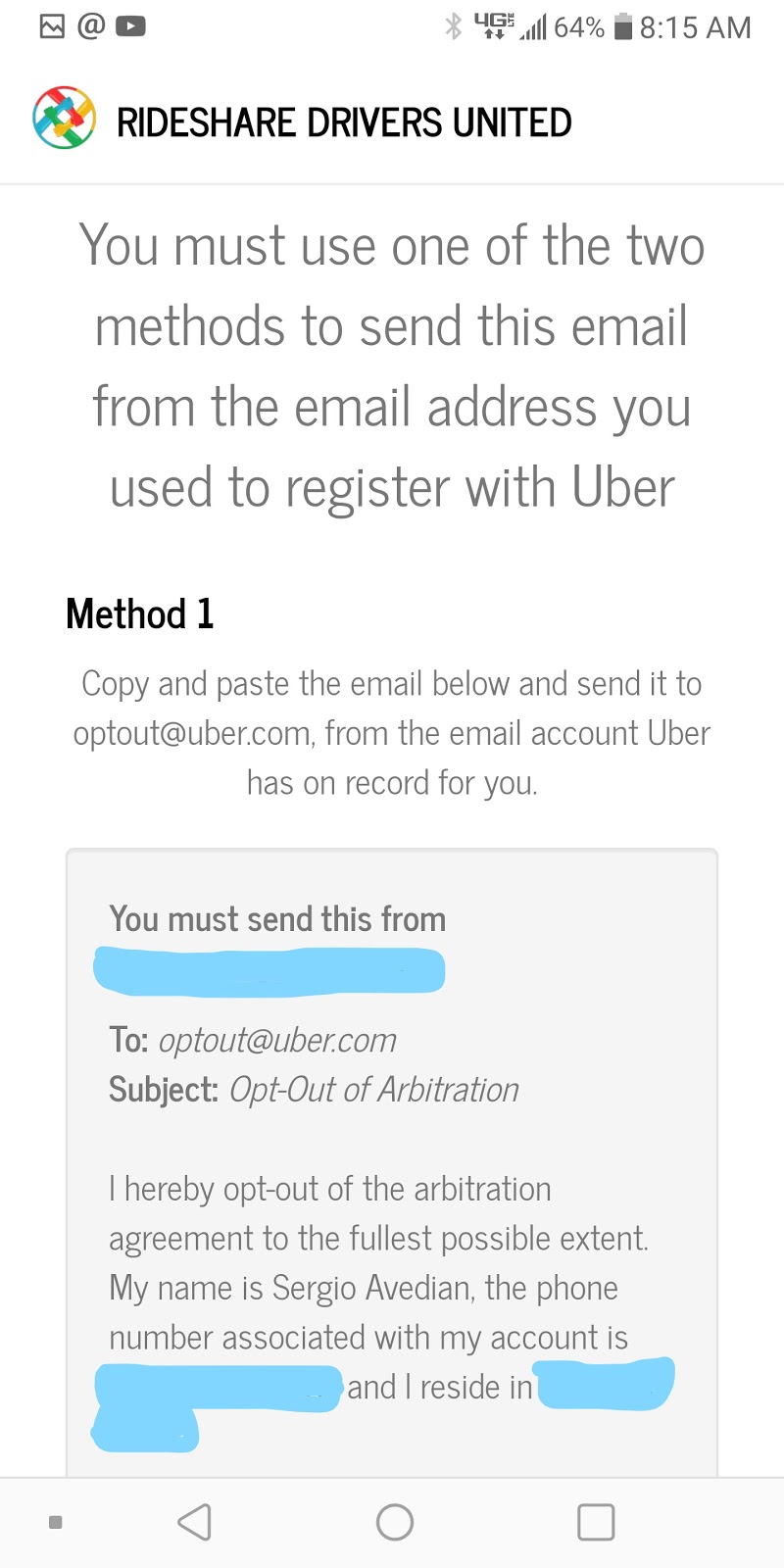
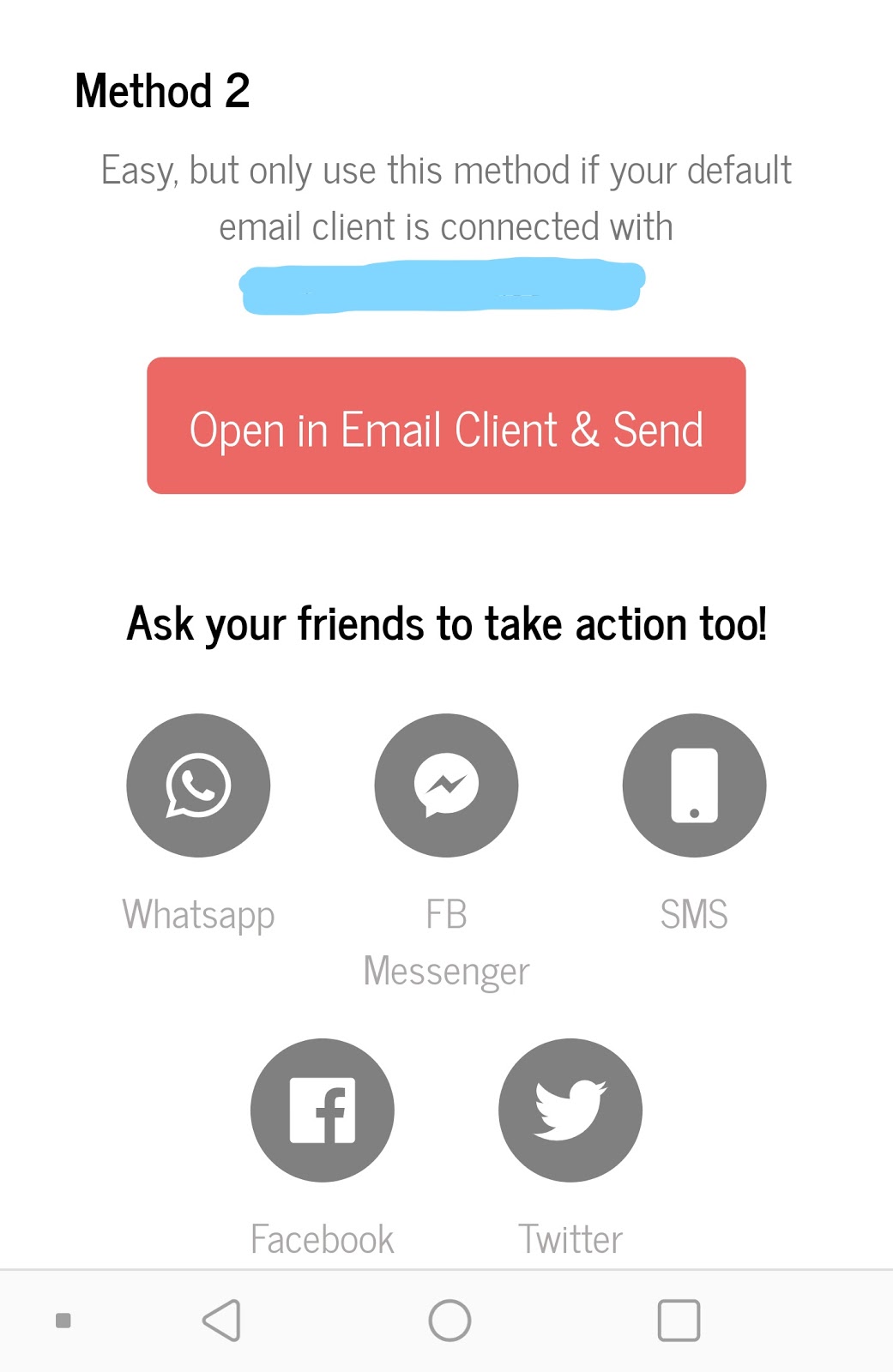
Once you complete the required information, the app will prepare an opt out email to be sent from your default email address. Make sure this email address is the same as your Uber driver account. This is the actual email I sent to optout@uber.com and what I received from Uber as confirmation.
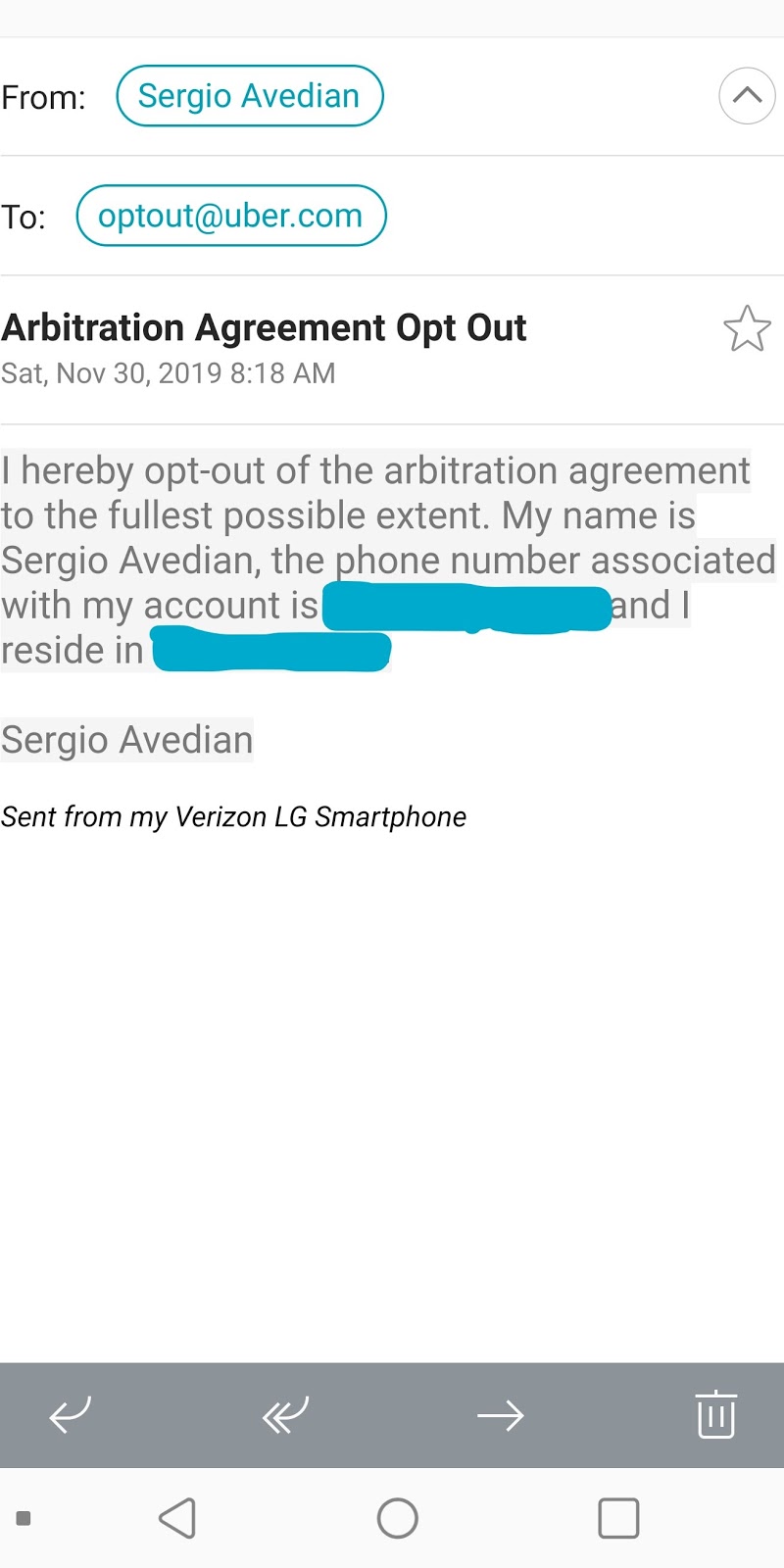
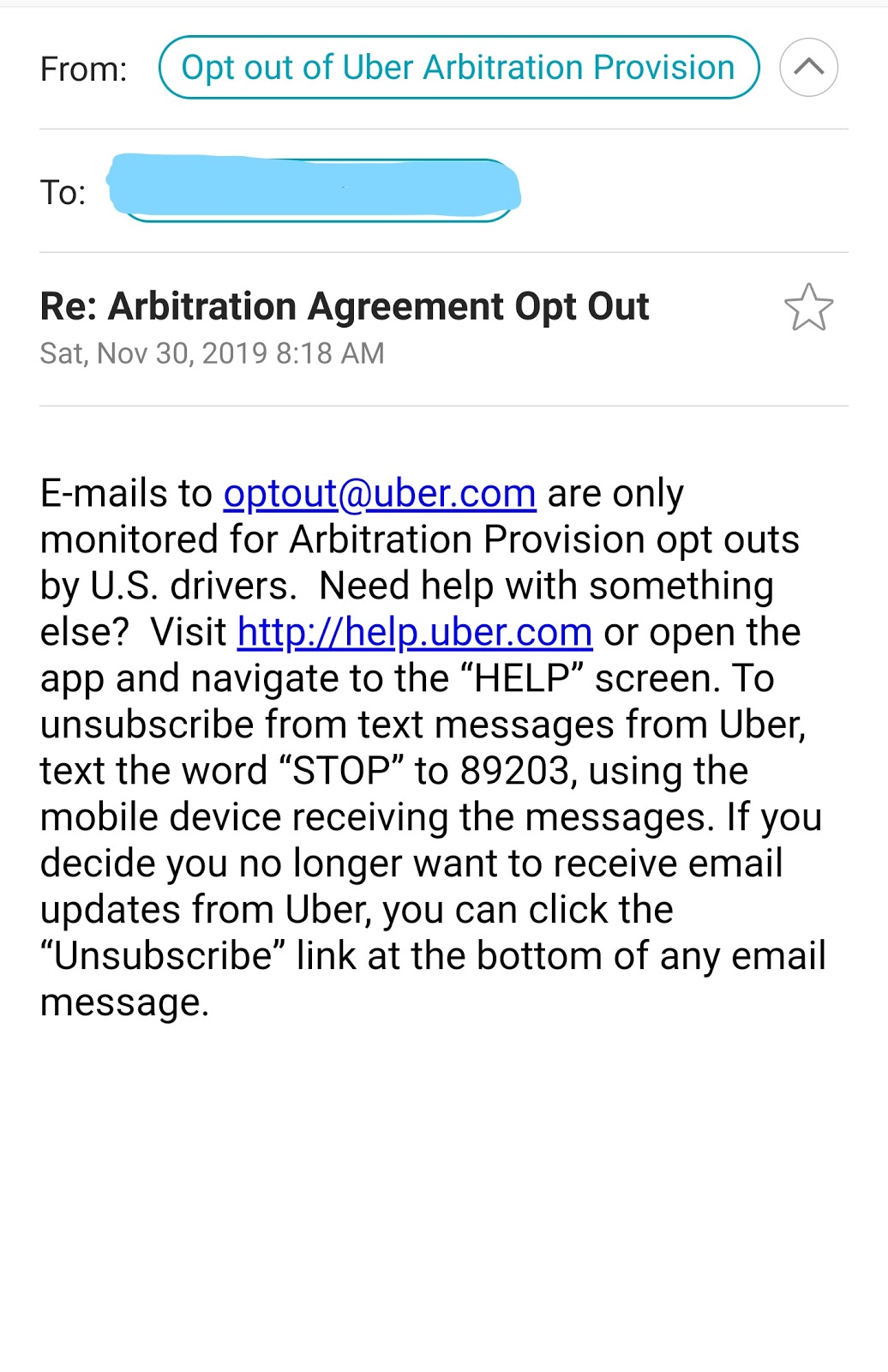
Should You Opt Out of Arbitration?
The following screenshots below represent excerpts from the updated agreement that pertains to arbitration and opting out of it. If you just sign the updated TOS and don’t opt out within the allotted 30 day limit, you will be forced to go to mandatory arbitration for future disputes and will lose your right to be a part of a class action lawsuit.
I personally have opted out of the past agreements and, per Uber, they will not retaliate by deactivating a driver for doing so. I am still around, so there must be some validity to that argument.
The following tweets may shed some light on the issue of arbitration by Harry and others. I hope he can have Veena Dubal as a guest on the Rideshare Guy podcast soon. She is widely regarded as the top legal expert on the gig economy.
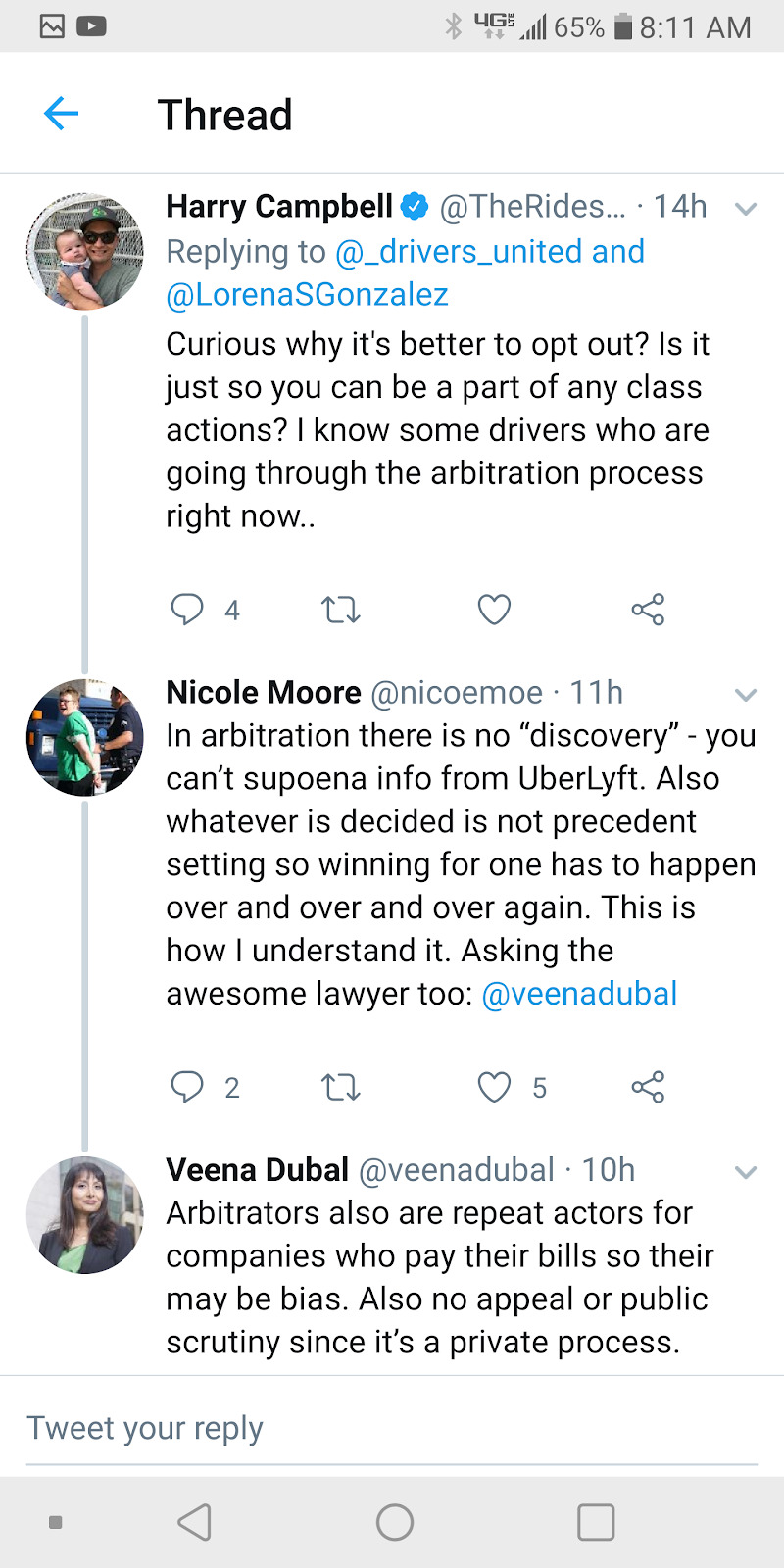
According to Uber, you won’t be penalized for opting out of arbitration:
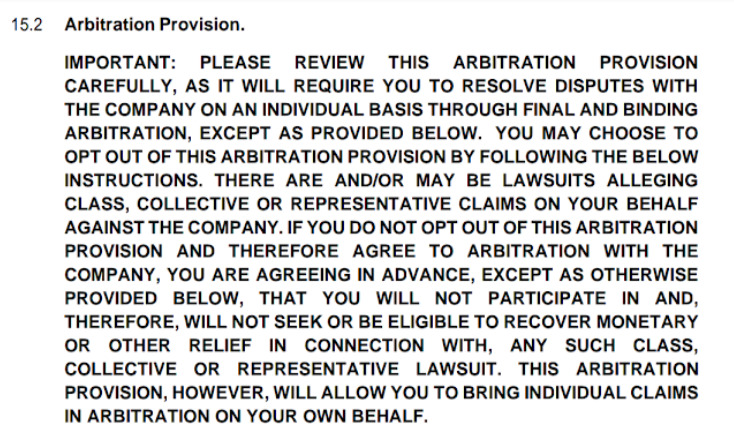

Why Should We Care About Arbitration from a Driver’s Perspective?
Mandatory arbitration contracts from other gig-economy companies, like DoorDash, Instacart and the like, may be on shaky ground thanks to a combination of recent rulings. The U.S. Supreme Court ruled this year that contractors as well as employees can be covered by an exemption for transportation workers in the federal law that requires the enforcement of arbitration pacts. At least one federal appeals court has ruled that drivers transporting passengers or delivering goods qualify for that exemption, as long as they’re involved in interstate commerce.
Whether drivers can avoid being forced into arbitration, though, may depend on whether courts decide dropping off passengers at the airport or delivering meals from local restaurants count as being engaged in interstate commerce—a question very much up in the air.
Driver classification lawsuits are hardly Uber’s only legal problem. In 2015, Uber was hit with 50 U.S. lawsuits—far more than any other so-called “Unicorn” start-up. The lawsuits challenge Uber’s business practices and could change the way it operates moving forward. You can check out the lawsuits settled by Uber via this link.
Uber’s employment litigation strategy has shown how powerful arbitration agreements can be in the gig economy. The fight over the classification of ride-sharing drivers as independent contractors appears to be over after Uber announced that it settled a pair of lawsuits for $20 million. The initial case, O’Connor v. Uber, was first brought by a group of Uber drivers in 2013 who argued they should be categorized as employees rather than independent contractors. By classifying drivers as contractors, Uber avoids providing benefits of traditional employment such as health insurance, paid sick time, and workers’ compensation, the drivers argued.
O’Connor v. Uber has been winding its way through the courts for over six years. It was almost settled in 2016, when Uber agreed to pay as much as $100 million to the roughly 385,000 drivers represented in the class action lawsuit and one other case, so long as it could continue to classify them as independent contractors. But the settlement was later rejected by a federal judge, who argued that the amount was insufficient. The US Supreme Court issued a ruling bolstering the power of employers to force workers to use individual arbitration instead of class action lawsuits.
Last year, the Ninth US Circuit Court of Appeals reversed O’Connor v. Uber’s class certification status, nullifying the decision on the ground that Uber’s arbitration clause prohibits class actions. The appeals court ruling ultimately reduced the size of the class to about 13,600 drivers who will participate in the settlement.
Shannon Liss-Riordan, an attorney representing Uber drivers in the case, said she was “pleased” with the settlement. Under the agreement, drivers will receive approximately 37 cents per mile for the miles they have driven for Uber, she said. Also, Uber agrees to better explain its deactivation policy to drivers, create a deactivation appeals process, and help drivers who were deactivated get back on the platform. Drivers who were removed from the lawsuit by the appeals court ruling would need to pursue their claims in individual arbitration if they want any relief.
Are you interested in learning more about the arbitration process, particularly for your state? Sign up to get notified here!
What will you do? Will you opt out? Is arbitration worth your time and money? Have you opted out of previous agreements or updates?
-Sergio and Paula @ RSG


